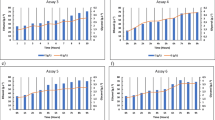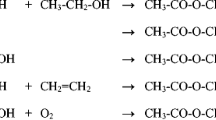Abstract
The production of the major volatile carbon compounds corresponding to the predominant higher alcohols and esters synthesized during wine alcoholic fermentation was monitored using an online GC system. The accuracy and frequency of measurements made it possible to calculate kinetic parameters, in particular rates and specific rates of production. Using this original GC system and a model describing the evolution of the gas–liquid ratio during the fermentation process, kinetic gas–liquid balances of the synthesis of volatile compounds could be followed. This showed that, for esters—substantial proportions of which are lost in the off-gas (up to 40 % of the total production at 20 °C)—measurements of the liquid concentration, rather than of the total production (liquid content + losses), can lead to misinterpretations of yeast metabolism. The specific production rate of individual higher alcohols reached their maximum values before the exhaustion of the corresponding precursor amino acids. Isobutanol and isoamyl alcohol were formed from carbon metabolites and nitrogen metabolites and consequently were produced continuously throughout the fermentation process. In contrast, propanol synthesis was strongly correlated with the presence of assimilable nitrogen, during both the growth and stationary phases. Therefore, propanol appears to be a highly pertinent marker of nitrogen metabolism. Acetate ester concentrations correlated linearly with the concentrations of the corresponding higher alcohols, indicating that the availability of the precursors is the main limiting factor for the production of these esters. These results open possibilities for innovative approaches based on metabolic flux analysis and taking their dynamics into account.







Similar content being viewed by others
References
Beltran, G., Esteve-Zarzoso, B., Rozes, N., Mas, A., & Guillamon, J. M. (2005). Influence of the timing of nitrogen additions during synthetic grape must fermentations on fermentation kinetics and nitrogen consumption. Journal of Agricultural and Food Chemistry, 53(4), 996–1002.
Boulton, R. B., Singleton, V. L., Bisson, L. F., & Kunkee, R. E. (1995). Principles and practices of winemaking. New York: Chapman & Hall.
Carrau, F. M., Medina, K., Farina, L., Boido, E., Henschke, P. A., & Dellacassa, E. (2008). Production of fermentation aroma compounds by Saccharomyces cerevisiae wine yeasts: effects of yeast assimilable nitrogen on two model strains. FEMS Yeast Research, 8(7), 1196–1207.
Clement, T., Perez, M., Mouret, J. R., Sanchez, I., Sablayrolles, J. M., & Camarasa, C. (2013). Metabolic responses of yeast to valine and ammonium pulses during four-stage continuous wine fermentation. Applied and Environmental Microbiology. doi:10.1128/AEM.02853-12.
Crepin, L., Nidelet, T., Sanchez, I., Dequin, S., & Camarasa, C. (2012). Sequential use of nitrogen compounds by Saccharomyces cerevisiae during wine fermentation: a model based on kinetic and regulation characteristics of nitrogen permeases. Applied and Environmental Microbiology, 78(22), 8102–8111.
Escudero, A., Campo, E., Farina, L., Cacho, J., & Ferreira, V. (2007). Analytical characterization of the aroma of five premium red wines. Insights into the role of odor families and the concept of fruitiness of wines. Journal of Agricultural and Food Chemistry, 55(11), 4501–4510.
Ferreira, V., Lopez, R., & Cacho, J. (2000). Quantitative determination of the odorants of young red wines from different grape varieties. Journal of the Science of Food and Agriculture, 80(11), 1659–1667.
Ferreira, V., Ortin, N., Escudero, A., Lopez, R., & Cacho, J. (2002). Chemical characterization of the aroma of Grenache rose wines: aroma extract dilution analysis, quantitative determination, and sensory reconstitution studies. Journal of Agricultural and Food Chemistry, 50(14), 4048–4054.
Francis, I. L., & Newton, J. L. (2005). Determining wine aroma from compositional data. Australian Journal of Grape and Wine Research, 11(2), 114–126.
Garde-Cerdan, T., & Ancin Azpilicueta, C. (2008). Effect of the addition of different quantities of amino acids to nitrogen-deficient must on the formation of esters, alcohols, and acids during wine alcoholic fermentation. LWT—Food Science and Technology, 41(3), 501–510.
Goelzer, A., Charnomordic, B., Colombie, S., Fromion, V., & Sablayrolles, J. M. (2009). Simulation and optimization software for alcoholic fermentation in winemaking conditions. Food Control, 20(7), 635–642.
Gonzalez-Marco, A., Jimenez-Moreno, N., & Ancin-Azpilicueta, C. (2010). Influence of nutrients addition to nonlimited-in-nitrogen must on wine volatile composition. Journal of Food Science, 75(4), 206–211.
Guidici, P., Zambonelli, C., & Kunkee, R. E. (1993). Increased production of n-propanol in wine by yeast strains having an impaired ability to form hydrogen sulfide. American Journal of Enology and Viticulture, 44(1), 17–21.
Guth, H. (1997). Quantitation and sensory studies of character impact odorants of different white wine varieties. Journal of Agricultural and Food Chemistry, 45(8), 3027–3032.
Hazelwood, L. A., Daran, J. M., van Maris, A. J. A., Pronk, J. T., & Dickinson, J. R. (2008). The Ehrlich pathway for fusel alcohol production: a century of research on Saccharomyces cerevisiae metabolism. Applied and Environmental Microbiology, 74(8), 2259–2266.
Hernandez-Orte, P., Bely, M., Cacho, J., & Ferreira, V. (2006). Impact of ammonium addition on volatile acidity, ethanol, and aromatic compounds production by different Saccharomyces cerevisiae strains during fermentation in controlled synthetic media. Australian Journal of Grape and Wine Research, 12(2), 150–160.
Ivanova, V., Stefova, M., Vojnoski, B., Stafilov, T., Biro, I., Bufa, A., et al. (2013). Volatile composition of Macedonian and Hungarian wines assessed by GC/MS. Food and Bioprocess Technology. doi:10.1007/s11947-011-0760-y.
Jimenez-Marti, E., Aranda, A., Mendes-Ferreira, A., Mendes-Faia, A., & Li del Olmo, M. (2007). The nature of the nitrogen source added to nitrogen depleted vinifications conducted by a Saccharomyces cerevisiae strain in synthetic must affects gene expression and the levels of several volatile compounds. Antonie Van Leeuwenhoek, 92(1), 61–75.
Le, S., Josse, J., & Husson, F. (2008). FactoMineR: an R package for multivariate analysis. Journal of Statistical Software, 25(1), 1–18.
Lilly, M., Lambrechts, M. G., & Pretorius, I. S. (2000). Effect of increased yeast alcohol acetyltransferase activity on flavor profiles of wine and distillates. Applied and Environmental Microbiology, 66(2), 744–753.
Lilly, M., Bauer, F. F., Lambrechts, M. G., Swiegers, J. H., Cozzolino, D., & Pretorius, I. S. (2006a). The effect of increased yeast alcohol acetyltransferase and esterase activity on the flavour profiles of wine and distillates. Yeast, 23(9), 641–659.
Lilly, M., Bauer, F. F., Styger, G., Lambrechts, M. G., & Pretorius, I. S. (2006b). The effect of increased branched-chain amino acid transaminase activity in yeast on the production of higher alcohols and on the flavour profiles of wine and distillates. FEMS Yeast Research, 6(5), 726–743.
Malherbe, S., Fromion, V., Hilgert, N., & Sablayrolles, J. M. (2004). Modeling the effects of assimilable nitrogen and temperature on fermentation kinetics in enological conditions. Biotechnology and Bioengineering, 86(3), 261–272.
Mauricio, J. C., Moreno, J., Zea, L., Ortega, J. M., & Medina, M. (1997). The effect of grape must fermentation conditions on volatile alcohols and esters formed by Saccharomyces cerevisiae. Journal of the Science of Food and Agriculture, 75(2), 155–160.
Mendes-Ferreira, A., Barbosa, C., Falco, V., Leao, C., & Mendes-Faia, A. (2009). The production of hydrogen sulphide and other compounds by wine strains of Saccharomyces cerevisiae in synthetic media with different nitrogen concentrations. Journal of Industrial Microbiology and Biotechnology, 36(4), 571–583.
Miller, A. C., Wolff, S. R., Bisson, L. F., & Ebeler, S. E. (2007). Yeast strain and nitrogen supplementation: dynamics of volatile ester production in Chardonnay juice fermentations. American Journal of Enology and Viticulture, 58(4), 470–483.
Molina, A. M., Swiegers, J. H., Varela, C., Pretorius, I. S., & Agosin, E. (2007). Influence of wine fermentation temperature on the synthesis of yeast-derived volatile aroma compounds. Applied Microbiology and Biotechnology, 77(3), 675–687.
Morakul, S., Athes, V., Mouret, J. R., & Sablayrolles, J. M. (2010). Comprehensive study of the evolution of gas–liquid partitioning of aroma compounds during wine alcoholic fermentation. Journal of Agricultural and Food Chemistry, 58(18), 10219–10225.
Morakul, S., Mouret, J. R., Nicolle, P., Trelea, I. C., Sablayrolles, J. M., & Athes, V. (2011). Modelling of the gas–liquid partitioning of aroma compounds during wine alcoholic fermentation and prediction of aroma losses. Process Biochemistry, 46(5), 1125–1131.
Morakul, S., Mouret, J. R., Nicolle, P., Aguera, E., Sablayrolles, J. M., & Athes, V. (2013). A dynamic analysis of higher alcohol and ester release during winemaking fermentations. Food and Bioprocess Technology, 6(3), 818–827.
Moreira, N., de Pinho, P. G., Santos, C., & Vasconcelos, I. (2011). Relationship between nitrogen content in grapes and volatiles, namely heavy sulphur compounds, in wine. Food Chemistry, 126(4), 1599–1607.
Mouret, J. R., Morakul, S., Nicolle, P., Athes, V., & Sablayrolles, J. M. (2012). Gas–liquid transfer of aroma compounds during winemaking fermentations. LWT—Food Science and Technology, 49(2), 238–244.
Sablayrolles, J. M. (2009). Control of alcoholic fermentation in winemaking. Current situation and prospects. Food Research International, 42(4), 418–424.
Saerens, S. M. G., Duong, C. T., & Nevoigt, E. (2010). Genetic improvement of brewer’s yeast: current state, perspectives and limits. Applied Microbiology and Biotechnology, 86(5), 1195–1212.
Styger, G., Jacobson, D., & Bauer, F. F. (2011). Identifying genes that impact on aroma profiles produced by Saccharomyces cerevisiae and the production of higher alcohols. Applied Microbiology and Biotechnology, 91(3), 713–730.
Sumby, K. M., Grbin, P. R., & Jiranek, V. (2010). Microbial modulation of aromatic esters in wine: current knowledge and future prospects. Food Chemistry, 121(1), 1–16.
Swiegers, J. H., Bartowsky, E. J., Henschke, P. A., & Pretorius, I. S. (2005). Yeast and bacterial modulation of wine aroma and flavour. Australian Journal of Grape and Wine Research, 11(2), 139–173.
Torrea, D., Fraile, P., Garde, T., & Ancin, C. (2003). Production of volatile compounds in the fermentation of Chardonnay musts inoculated with two strains of Saccharomyces cerevisiae with different nitrogen demands. Food Control, 14(8), 565–571.
Torrea, D., Varela, C., Ugliano, M., Ancin-Azpilicueta, C., Francis, I. L., & Henschke, P. A. (2011). Comparison of inorganic and organic nitrogen supplementation of grape juice—effect on volatile composition and aroma profile of a Chardonnay wine fermented with Saccharomyces cerevisiae yeast. Food Chemistry, 127(3), 1072–1083.
Ugliano, M., Travis, B., Francis, I. L., & Henschke, P. A. (2010). Volatile composition and sensory properties of Shiraz wines as affected by nitrogen supplementation and yeast species: rationalizing nitrogen modulation of wine aroma. Journal of Agricultural and Food Chemistry, 58(23), 12417–12425.
Van Der Sluis, C., Rahardjo, Y. S. P., Smit, B. A., Kroon, P. J., Hartmans, S., Ter Schure, E. G., et al. (2002). Concomitant extracellular accumulation of alpha-keto acids and higher alcohols by Zygosaccharomyces rouxii. Journal of Bioscience and Bioengineering, 93(2), 117–124.
Vilanova, M., Ugliano, M., Varela, C., Siebert, T., Pretorious, I., & Henschke, P. (2007). Assimilable nitrogen utilisation and production of volatile and non-volatile compounds in chemically defined medium by Saccharomyces cerevisiae wine yeasts. Applied Microbiology and Biotechnology, 77(1), 145–157.
Vilanova, M., Siebert, T. E., Varela, C., Pretorius, I. S., & Henschke, P. A. (2012). Effect of ammonium nitrogen supplementation of grape juice on wine volatiles and non-volatiles composition of the aromatic grape variety Albarino. Food Chemistry, 133(1), 124–131.
Acknowledgments
We thank Carole Camarasa for her help concerning the metabolic analyses, Evelyne Aguera for performing fermentations, and Isabelle Sanchez for her help with statistical analysis. The research generating these results was funded by the European Community Seventh Framework Programme (FP7/2007e2013) under grant agreement CAFE no KBBE-212754 (http://www.cafe-project.org). This study was also supported by the INRA Sys-Aromes program and by the BIOFLAVOUR Cost Action FA0907.
Author information
Authors and Affiliations
Corresponding author
Rights and permissions
About this article
Cite this article
Mouret, J.R., Perez, M., Angenieux, M. et al. Online-Based Kinetic Analysis of Higher Alcohol and Ester Synthesis During Winemaking Fermentations. Food Bioprocess Technol 7, 1235–1245 (2014). https://doi.org/10.1007/s11947-013-1089-5
Received:
Accepted:
Published:
Issue Date:
DOI: https://doi.org/10.1007/s11947-013-1089-5




